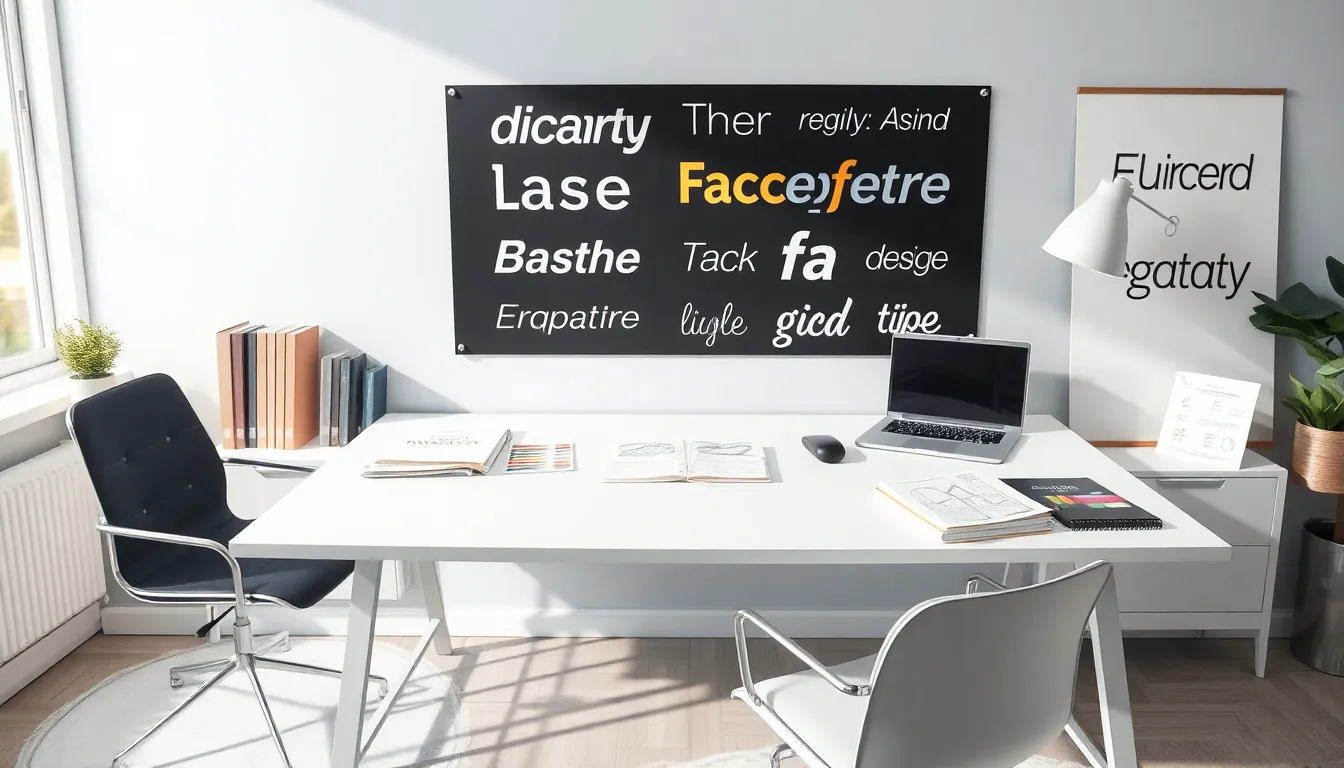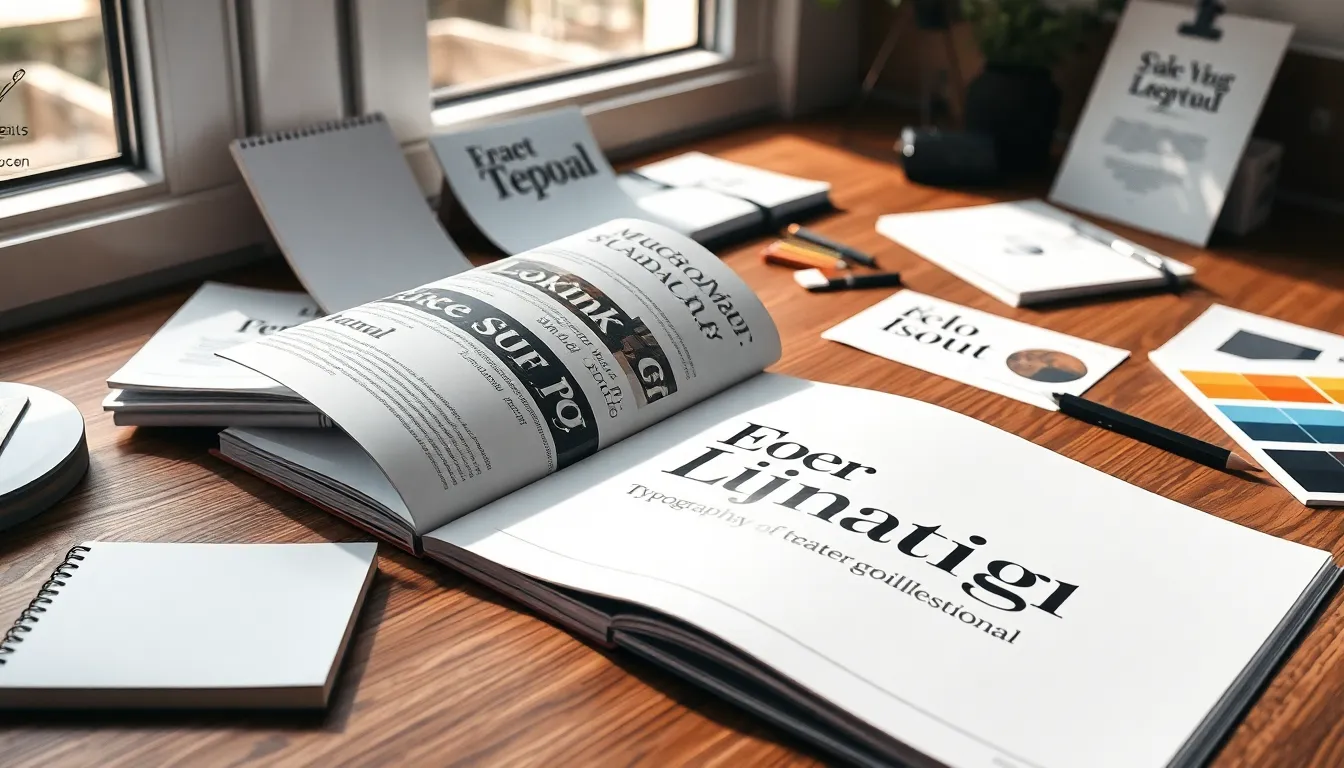Table of Contents
ToggleTypography isn’t just about letters; it’s an art form that can make or break a design. In the world of visual storytelling, the right typeface can evoke emotions, convey messages, and even spark joy. Enter the Typography Design Magazine, where fonts strut their stuff and kerning gets the spotlight it deserves.
Overview of Typography Design Magazine
Typography Design Magazine serves as a crucial resource for designers interested in the art of typography. It showcases a variety of fonts that cater to different aesthetic needs and audience preferences. The magazine features expert insights into the selection process of typefaces and their impact on reader perception.
Each issue highlights trends and innovations in typography that influence modern design practices. Readers discover in-depth articles on the nuances of kerning, leading, and tracking, which are essential for mastering typography. The publication also includes interviews with renowned typographers who share their experiences and creative processes.
Practical tips for implementing effective typography in design projects are presented throughout the magazine. Special sections dedicated to case studies offer real-world examples of successful typographic applications. Focus on the historical context of typefaces adds depth to the understanding of typography’s evolution.
Moreover, Typography Design Magazine engages its audience with visually striking layouts that exemplify best practices in typography. Contests and challenges encourage readers to experiment with new fonts and share their designs. Overall, the magazine fosters a community of typography enthusiasts eager to expand their knowledge and skills in this vital design element.
Key Features of the Magazine

Typography Design Magazine presents essential features for design enthusiasts. Each aspect contributes to its reputation as a fundamental resource in typography.
Content Variety
Content provides an extensive range of articles, ensuring all aspects of typography receive coverage. It highlights various typefaces, from serif to sans-serif, examining their applications in different design contexts. Readers find tutorials on technical skills like kerning and leading, as well as insights into trends and innovations. Interviews with industry leaders and typographers offer firsthand knowledge. Special sections showcase successful case studies, allowing readers to see real-world applications. Typography Design Magazine satisfies diverse interests, making it valuable for both novice and expert designers.
Design Quality
Design quality in Typography Design Magazine stands out for its visual appeal and usability. Each issue features clean layouts that enhance readability and engagement. High-resolution images showcase fonts and typographic designs, capturing the intricacies of each style. Thoughtfully chosen color palettes complement the text and imagery, creating a harmonious overall look. Consistent formatting provides a seamless reading experience, allowing readers to focus on content. Typography Design Magazine prioritizes aesthetic excellence, which aligns with the broader goals of design education and inspiration.
Target Audience
Typography Design Magazine targets a diverse audience, including designers, educators, and students. Each group benefits uniquely from the magazine’s rich content.
Designers and Creatives
Designers and creative professionals rely on Typography Design Magazine for inspiration and practical knowledge. They discover cutting-edge trends in typography that influence their work. This publication showcases a range of typefaces suitable for various design projects, enhancing their creative toolkit. Insights from industry experts often illuminate the nuances of type selection, helping designers communicate effectively through their art. Creative individuals can also engage with competitions featured in the magazine, providing opportunities to experiment and showcase their typographic skills.
Educators and Students
Educators and students find Typography Design Magazine an invaluable resource for teaching and learning. This publication offers practical tutorials that simplify complex typography concepts. Students benefit from in-depth articles that explore the history and evolution of typography. Educators can utilize the magazine’s content for lesson plans, covering essential topics in typography design. Each issue encourages discussions about modern practices, enhancing the learning experience. Collaborative projects inspired by the magazine enable students to apply their knowledge creatively, thus fostering a deeper understanding of typography’s significance in design.
Importance of Typography in Design
Typography holds significant value in design, as it enhances visual communication. Effective type choice can evoke emotions and convey messages clearly. Designers rely on typography to create an engaging experience for the audience. Each typeface contributes uniquely to the overall aesthetic and functionality of a design project.
Understanding key typography principles is essential. Elements like kerning, leading, and tracking play pivotal roles in readability and visual impact. Mastering these aspects contributes to delivering the intended message with precision. Typography influences user perception, and well-chosen fonts can guide viewer responses.
Typography Design Magazine offers resources that highlight these vital elements. The publication showcases various fonts that cater to diverse design needs and audience preferences. Expert insights within its pages clarify the type selection process, helping designers make informed decisions. The magazine consistently features articles that discuss the latest typography trends, influencing modern design practices.
Engaging with Typography Design Magazine fosters a community of typography enthusiasts. Practical tips and case studies demonstrate successful typographic applications, encouraging creativity among readers. Interviews with renowned typographers provide inspiration and knowledge, enhancing the reader’s understanding of typography’s evolution over time.
This clear focus on typography establishes a deeper connection between text and visuals. Designers, educators, and students all benefit from studying these resources. Exploring the history and innovation of typefaces enriches one’s appreciation for typography in design. Thus, typography remains a fundamental element within the realm of visual arts.
Notable Articles and Contributions
Typography Design Magazine features a range of notable articles that delve into industry trends and valuable insights. Each issue offers expert contributions from established typographers, providing unique perspectives on typeface selection and usage. Articles often explore the emotional impact of typography, illustrating how different fonts can evoke specific feelings and enhance communication.
One standout piece discusses the significance of kerning, leading, and tracking in relation to readability. Writers emphasize how precise control of these elements can improve visual impact. Authors frequently share case studies that showcase successful typography applications in various design projects.
Another notable contribution highlights emerging typeface trends that shape modern design practices. Contributors analyze the influence of these trends on typography’s evolution and how they cater to diverse audience preferences. Engaging profiles of renowned typographers also grace the pages of the magazine, offering readers firsthand accounts of their design philosophies and inspirations.
Practical tips frequently appear throughout the articles, helping designers implement effective typography in their projects. Readers can find step-by-step tutorials that simplify complex concepts, making them accessible to designers of all skill levels. Challenges and contests encourage active participation, inviting readers to experiment with new fonts and share their results.
The magazine’s commitment to high-quality design is apparent not only in its content but also in its visually compelling layouts. Attractive designs paired with high-resolution images create an immersive reading experience that enhances audience engagement. Regular special sections focus on the historical context of typefaces, further enriching the understanding of typography’s role in visual arts.
Typography Design Magazine stands as an essential resource for anyone passionate about the art of typography. With its rich content and expert insights, it inspires designers to explore the nuances of typefaces and their impact on visual communication. The magazine not only showcases innovative trends but also fosters a vibrant community eager to share knowledge and creativity.
By engaging with Typography Design Magazine, readers can deepen their understanding of typography’s role in design, enhancing their skills and expanding their creative horizons. It’s a must-read for those looking to elevate their design projects and appreciate the beauty and complexity of typography.




